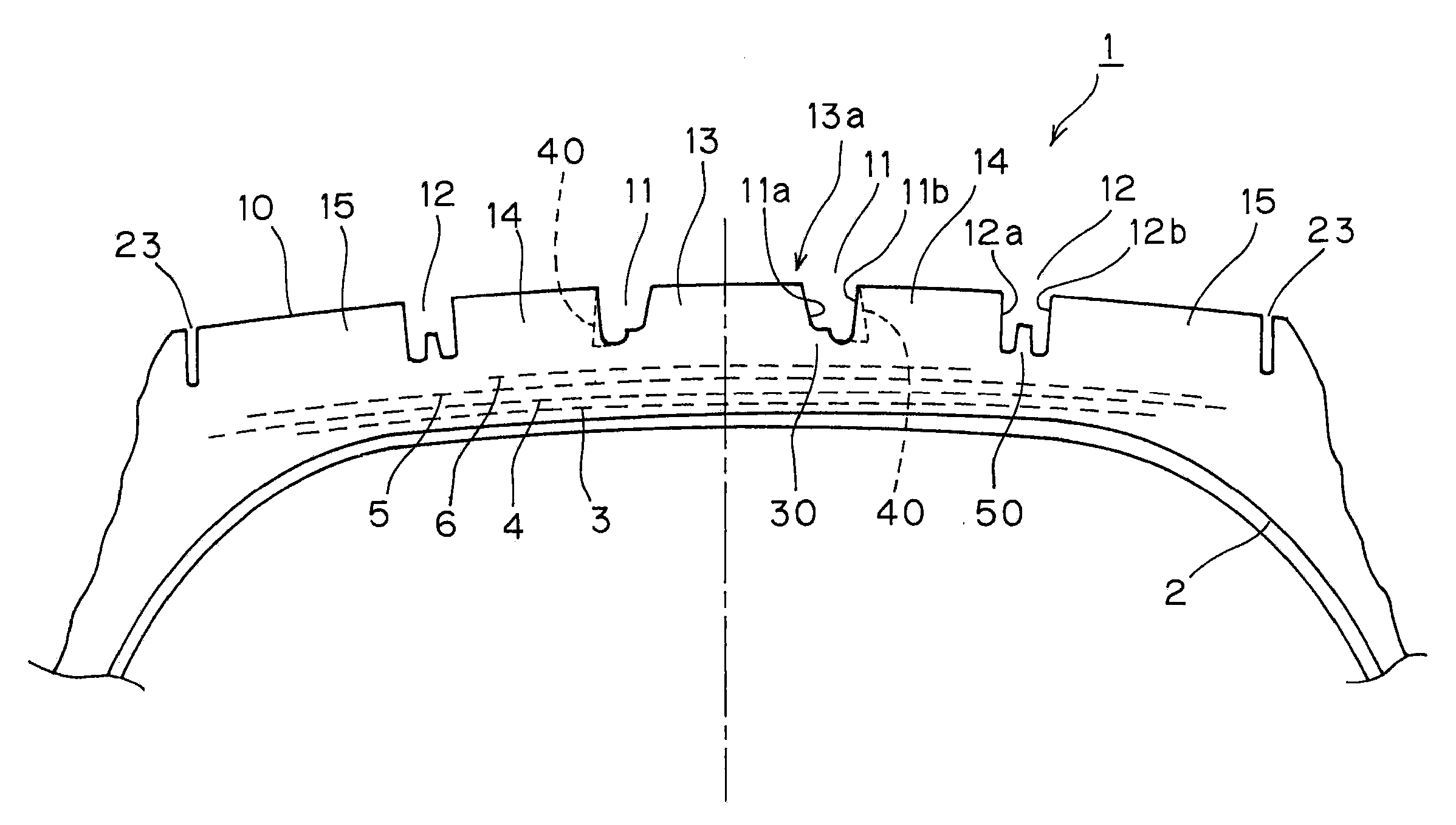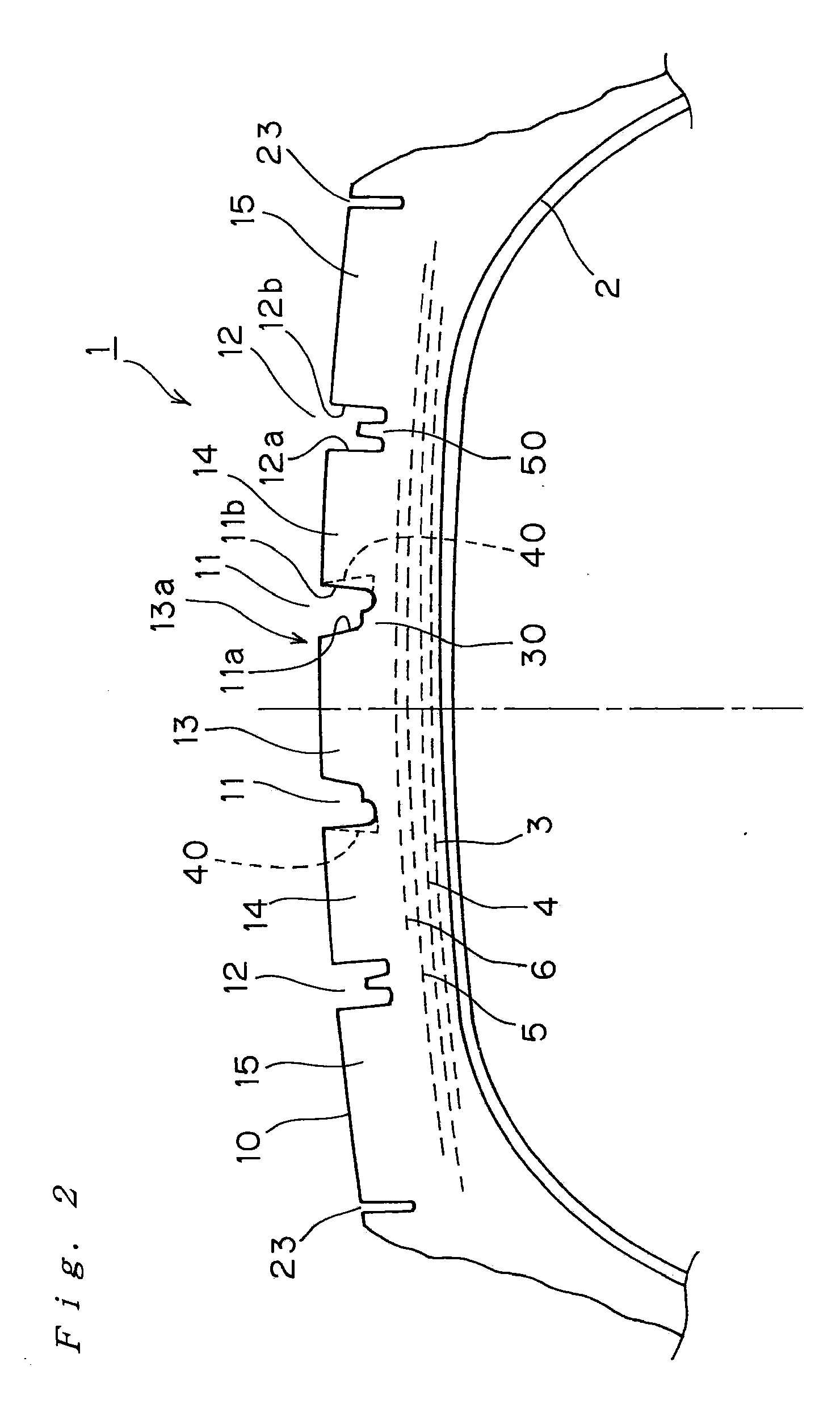[0011]In view of the problems described above, it is an object of the invention to provide a rib-patterned pneumatic tire in which uneven
wear resistance is improved by reducing movement of rubber on a
ground contact surface of a rib by restraining groove walls of a rib from bulging on load, stone-nipping resistance is improved, generation of cracks on the groove bottom is prevented and, in addition, braking property and driving property after having worn are secured.
[0013]According to the pneumatic tire of the invention configured as described above, with the provision of the stepped-shaped raised area on at least on one of the groove walls of the main groove positioned at the center area of the tire (referred also to as the tire center side) in the circumferential direction, the rigidity of the ribs is secured without increasing the width of the ribs formed by the main grooves so that the
wear resistance is improved and stone-nipping is prevented by the raised portion, so that the stone-nipping resistance is improved. With the provision of the zigzag shape including the repetitive peaks and troughs circumferentially on the wall portion of the raised area, the proximal portion of the rib is removed, and hence the rigidity thereof is lowered relatively with respect to the
rib surface, so that deformation of the groove wall on the surface side is restrained. In addition, the zigzag shape appears when having worn, and the braking property and the driving property may be secured on and after the medium phase of wear so that the control stability is maintained.
[0014]The main groove positioned on both outsides (referred also to as the shoulder sides) of the main groove positioned at the center area of the tire are each adapted in such a manner that when the thickness of rubber at the bottom portion of the main groove is thinner than that of the rib portion, and when the belt ply on the outermost layer is arranged inside the shoulder-side main grooves, the groove walls of the rib is deformed to bulge as if they are convoluted toward the center side with the groove bottoms as fulcrums and the
tread surface is moved when it comes into contact with the ground. Therefore, by enhancing the rigidity of the groove bottom with the
ridge provided at the center portion of the groove, the stress caused by the deformation can be absorbed. In contrast to the V-shaped main groove in the related art in which the
angle of inclination of the groove walls exceeds 10°, the angles of inclinations of the groove walls of the main groove with respect to the normal lines of the tread surface at the portion where the main groove exists are set to be parallel to each other or to be 5° or smaller in the direction to reduce the width of the grooves of the main grooves on the radially inside of the tire, so that the
ground contact pressure of the rib ends is lowered and hence deterioration of wear resistance due to the deformation is restrained. The normal line of the tread surface of the main groove portion represents the normal line with respect to the tangential line with respect to the ends of the main groove of a standard rim prescribed by the TRA (the Tire and Rim Association) with prescribed air pressure / no load state.
[0015]The
ridge restrains the stone-nipping into the main groove, and restrains shear deformation of the groove wall of the rib on the grounded ends toward the center of the tire due to a lateral force applied thereto when a vehicle is turned. Therefore, the ridge is disposed independently from the groove walls on both sides so as not to impair the deformation of the rib ends.
[0016]With the provision of the zigzag notches formed into a triangular
pyramid shape directed toward the groove bottom on one of the groove walls of the main groove positioned at the center area of the tire circumferentially of the tire at regular intervals, the rigidity of the proximal portion of the rib is reduced to cause the bulging of the groove wall surface on load to move toward the groove bottom and reduce the extent of movement of the rubber at the rib ends on the ground contact surface, that is, the widthwise movement at the rib ends, so that the uneven wear resistance is improved. In addition, the zigzag shape appears on the tread surface in association with the progress of wear, so that the braking property and driving property on the wet road are also secured.
[0017]Furthermore, with the arrangement of the peaks and the troughs of the wall portion of the raised area and of the triangular
pyramid shapes at the same intervals in such a manner that the peaks and the troughs of them are arranged so as to oppose to each other in pairs with the intermediary of the main groove, the width of the groove bottom is secured and hence water drainage property is secured, and the
radius of curvature (R) for joining the groove bottom and the groove wall continuously is set to be a relatively large value, so that generation of cracks on the groove bottom may be restrained.
 Login to View More
Login to View More  Login to View More
Login to View More 


